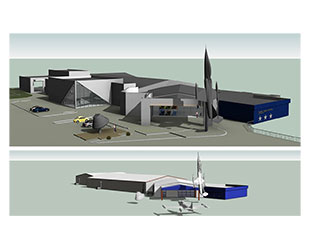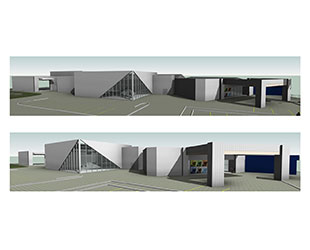Dec. 29, 2017 – Twenty five years after it was founded, an astronaut's hometown museum is looking to expand – just in time to mark a half century since its namesake's historic flight to the moon.
The Stafford Air & Space Museum, named for Gemini and Apollo astronaut Thomas Stafford, announced its "Legacy Campaign," a major fund-raising effort to grow its facilities by more than 18,000 square feet (1,670 sq. meters). The museum, located in Weatherford, Oklahoma, aims to have the first phase of the expansion completed in time to host a celebration for the 50th anniversary of Stafford's Apollo 10 mission in May 2019.
"It is important to do this campaign while General Stafford can actively participate and enjoy firsthand the excitement and impact this expansion brings to the public," stated Jeff DeFehr, chair of the Legacy Campaign for the museum.
Founded in 1993 when a small display at the local airport grew to fill a two-room exhibition, the Stafford Air & Space Museum today encompasses over an acre of aviation and space installations. Among the artifacts showcased by the Smithsonian affiliate are a ten-story Titan II rocket and an extensive collection of rocket engines, including a Saturn V F-1 engine and a flown space shuttle main engine.

Architectural concept for the expansion (at top) of the Stafford Air & Space Museum (at bottom). (Stafford Air & Space Museum) |
The new $3 million expansion — of which $1.4 million has been pledged to date — will increase the museum footprint to almost 60,000 sq. feet (5,600 sq. meters). It will provide the space for more artifacts to be put on display, including NASA's fixed-base simulator used to train all of the shuttle crews and fragments of the original Wright Flyer that were carried to the moon on the Apollo 11 mission.
The Stafford Legacy Campaign, along with the cooperation of NASA, the Smithsonian and the National Museum of the U.S. Air Force in Dayton, Ohio, will also make possible the world's most extensive exhibit of artifacts from the Gemini program. Stafford made his first two spaceflights on board the fifth and seventh Gemini missions, Gemini 6A and 9A, in 1965 and 1966, respectively.
In addition, the expansion will provide the resources for the commission of a full-size replica of "Snoopy," the first lunar lander to be flown in orbit around the moon by Stafford and his Apollo 10 crewmate, Gene Cernan, in May 1969. The Apollo 10 mission served as a dress rehearsal for the first crewed landing on the moon just two months later.
"When humans first left the safety of the Earth to venture into the skies and the moon beyond, these were two of mankind's greatest achievements," said Max Ary, director of the Stafford Air & Space Museum. "We must keep that spirit of exploration alive in this country, and remind current and future generations what this nation can accomplish when it puts its collective hearts and minds to a common goal."
"The museum stands witness to when America was at its best," said Ary.

Concept for the Stafford Air & Space Museum's entrance, building expansion and restoration facility. (Stafford Air & Space Museum) |
The Legacy Campaign will further upgrade the museum's existing exhibits with immersive, interactive and high-tech features to help bring history and the artifacts to life. The expansion will provide more room for the museum to host events, temporary exhibits and the museum's gift shop, as well as a facility to restore artifacts, such as the cockpit of a Boeing B-52 "Stratofortress" aircraft that is waiting repair and conservation.
The Stafford Air & Space Museum's mission is to not only preserve Thomas Stafford's legacy, but to also inspire and educate future generations to dare themselves to be great.
"This museum is not about me!" stressed Stafford, who is now 87. "It is dedicated to the American spirit of dreaming the impossible and making those dreams happen."
"I grew up in a small western Oklahoma town during the Dust Bowl and Depression, and I flew to the moon," added Stafford. "I'm living proof that nothing is impossible!"
For more information about the Legacy Campaign, see the Stafford Air & Space Museum's website.
